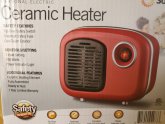D
Deleted member 783
Guest
I need a way to get some heat into my little 64 square foot shed where my batteries live. I'll do something permanent over the summer, but for now I just need something that works. I tried a Mr. Buddy propane heater, and my building is airtight, so the oxygen sensor shuts it off after a few minutes. I picked up this little heater to try. Am I figuring this right?:
250 watts / 110 volts = 2.73 amps
2.73 amps * 8ish hours of run time = 21.84 amp hours.
I have 2x200ah batteries in parallel, so 400ah- 200ah (safe dod) - 21.84=178.16 amp hours remaining.
Did I figure that correctly?
250 watts / 110 volts = 2.73 amps
2.73 amps * 8ish hours of run time = 21.84 amp hours.
I have 2x200ah batteries in parallel, so 400ah- 200ah (safe dod) - 21.84=178.16 amp hours remaining.
Did I figure that correctly?



